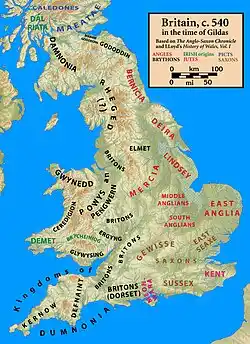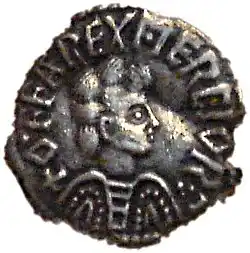
Anglo-Saxon surnames refers to the names which people bore in Anglo-Saxon England during the Early Middle Ages. This was an era before the widespread adoption of surnames across Europe in the High Middle Ages, late medieval and early modern periods. Thus, people did not have surnames in the modern sense of the word in Anglo-Saxon England, but they did have descriptors of a kind which denoted where they were from or provided some kind of description or another of their personality or appearance. These facets of an individual, their place of birth, physical appearance, character or occupation would later form the basis for more modern surnames when they developed centuries later, so Anglo-Saxon surnames or appellations are an important stepping stone towards the development of modern European surnames.
History of Anglo-Saxon surnamesHistory of Anglo-Saxon surnames

The history of surnames in Anglo-Saxon England is a story of decline and revival, one which mirrors the wider history of Anglo-Saxon England. In the fourth century CE, England was a peripheral part of the Roman Empire, one in which colonies of Roman settlers in places like Londinium (London), Aquae Sulis (Bath), Eboracum (York) and Camulodunum (Colchester) lived with their three-barrel, complicated Roman surnames. This all changed in the fifth century CE though. In 410, in response to the wider crisis of the Western Roman Empire, the Roman legions were tactically withdrawn from Britain to Gaul and the island was left to fend for itself. The period that followed in the fifth and sixth centuries, known to historians and archaeologists as Sub-Roman Britain, saw a gradual collapse of the vestiges of Roman society and the incursion of Germanic peoples from abroad, notably the Angles and the Saxons, from which the term Anglo-Saxon England derives. In the Dark Age that now commenced, Roman surnames began to disappear, as indeed did virtually all species of surnames.[1]
Matters only changed gradually as the Early Middle Ages progressed. For much of the fifth and sixth centuries the range of documentary source material for England and Britain is extremely limited. As such, there is very little written record of how people described one another or what names they used. When things began to change in the seventh century the ‘surnames’, if such they can be called, were much more primitive than what had preceded the Anglo-Saxons in Roman times. We simply find people being referred to as being ‘of’ a particular state. For instance, Offa of Mercia was a very important ruler of the eighth century who was noted as being ‘of Mercia’ because he ruled the Kingdom of Mercia that became the most powerful of the Anglo-Saxon kingdoms in England at that time. This pattern continued over the centuries that followed down to 1066 when the Anglo-Saxon period gave way to the Anglo-Norman era of English history. Yet as we will see, the naming conventions being used grew slightly more complicated over time.[2]
Anglo-Saxon naming conventionsAnglo-Saxon naming conventions

The naming conventions that the Anglo-Saxons were using did evolve between the seventh and eleventh centuries. For instance, when we first start finding written chronicles and records again after the Dark Age of the fifth and sixth centuries, we typically just find people being referred to as being ‘of’ the kingdom they ruled or lived in, ergo Offa of Mercia or Adda of Bernicia. Over time though these ‘surnames’ became more complicated. Instead of simply describing the broad kingdom where a person hailed from, they often became descriptors of their personality or achievements. In line with this, we find the great early eighth-century historian and cleric, Bede, being referred to eventually as Bede the Venerable, or to use the Latin version Beda Venerabilis.[3] A King of the English is later referred to Aethelred the Unready, on account of his conspicuous lack of preparedness to stave off the threat posed by the Danes to his rule in the late tenth and early eleventh centuries.[4] These may not seem like ‘surnames’ in the classical sense, but it is important to remember when assessing these that a great many surnames in a large number of national traditions are essentially based on how an ancestor was described or where they came from, things which the Anglo-Saxons were leaning towards in their use of these primitive ‘of’ and ‘the’ descriptions of eminent figures or nicknames.[5]
A complicating factor in all of this emerged from the ninth century onwards as Norse settlers from Scandinavia, or Danes, as they were more often known in England, began raiding and then conquering large parts of England, particularly Northumbria in the north of the country and East Anglia in the east. These brought their own naming traditions and the Vikings/Norse were relatively precocious in this respect. For instance, by the tenth and eleventh centuries some Norse people were already using straight-forward patronymic surnames where the suffix ‘-sson’ or ‘-son’ was added to the name of a person’s father or some other male forbear to form surnames like Eriksson or Godwinson. As a result, in the tenth and eleventh century in Anglo-Saxon England, as the country is still referred to as prior to the Norman Conquest of 1066, there were new Norse surnames muddying the waters of the surname landscape of England.[6]
Famous Anglo-SaxonsFamous Anglo-Saxons
- Penda of Mercia – A King of Mercia between the mid-620s and his death in 655, he laid the basis for the Mercian Supremacy over much of England in the seventh and early eighth centuries.[7]
- Bede the Venerable – Known as the Father of English History, in the early eighth century this Northumbrian monk composed the Ecclesiastical History of the English People, our greatest source for the history of England between the fifth and eighth centuries.[8]
- Aethelred of Wessex – Ruler of the Kingdom of Wessex in the south of England between 865 and 871 at a time when the Danes began settling in the north in large numbers.[9]
- Edward the Confessor – King of England between 1042 and 1066. His ‘surname’ ‘the Confessor’ reflects contemporary perceptions of him as particularly religious, almost saintly, though without suffering martyrdom.[10]
- Ralph the Timid – Earl of Hereford between 1051 and the mid-1050s, his name ‘the Timid’ was applied to him in a derogatory fashion owing to his perceived military incompetence.[11]
- Tostig Godwinson – An Anglo-Saxon who was Earl of Northumbria between 1055 and 1065. His surname is essentially of Danish construction and highlights the melding of Norse and Anglo-Saxon culture in England by the mid-eleventh century.[12]
See alsoSee also
Explore more about Anglo-Saxon surnamesExplore more about Anglo-Saxon surnames
- Why do have surnames? at English Heritage
- An Introduction to Early Medieval England at English Heritage
- Finding Your Medieval Roots: Five Simple Tips on the MyHeritage Blog
References
- ↑ https://the-orb.arlima.net/encyclop/early/origins/rom_celt/romessay.html
- ↑ Marc Morris, The Anglo-Saxons: A History of the Beginnings of England (London, 2021).
- ↑ https://www.historic-uk.com/HistoryUK/HistoryofEngland/The-Venerable-Bede/
- ↑ https://www.historic-uk.com/HistoryUK/HistoryofEngland/Aethelred-The-Unready/
- ↑ https://www.english-heritage.org.uk/visit/inspire-me/blog/blog-posts/norman-saxon-surname/
- ↑ Cat Jarman, River Kings: A New History of the Vikings from Scandinavia to the Silk Roads (London, 2021).
- ↑ Edwin Pace, ‘Geoffrey’s “Very Old Book” and Penda of Mercia’, in Arthuriana, Vol. 22, No. 2 (Summer, 2012), pp. 53–74.
- ↑ https://www.historic-uk.com/HistoryUK/HistoryofEngland/The-Venerable-Bede/
- ↑ https://www.britannica.com/biography/Aethelred-I
- ↑ https://www.historic-uk.com/HistoryUK/HistoryofEngland/Edward-The-Confessor/
- ↑ https://en.wikisource.org/wiki/Dictionary_of_National_Biography,_1885-1900/Ralph_the_Timid
- ↑ https://www.englishmonarchs.co.uk/saxon_31.html

